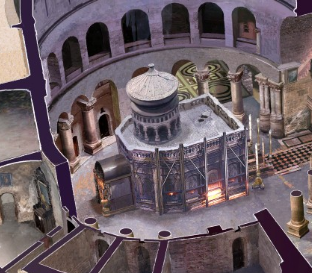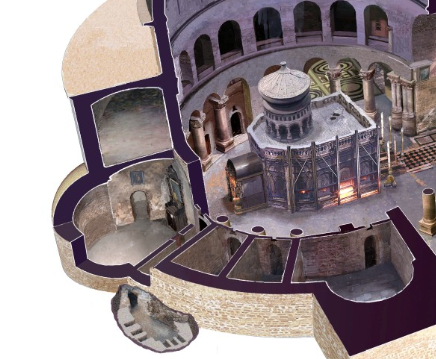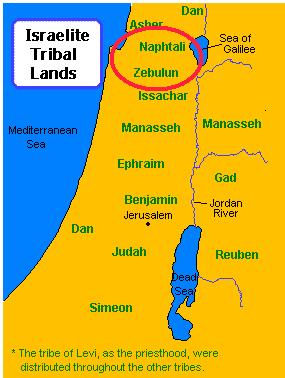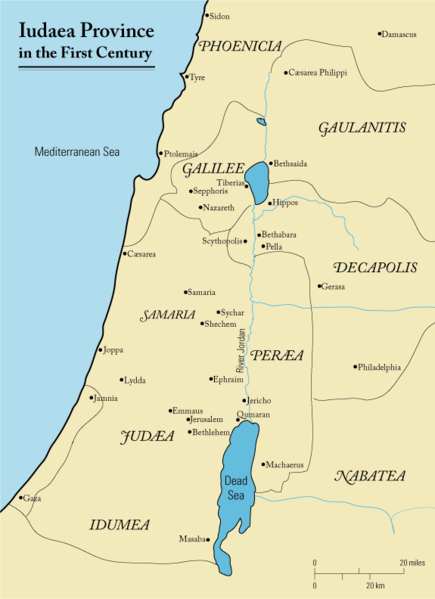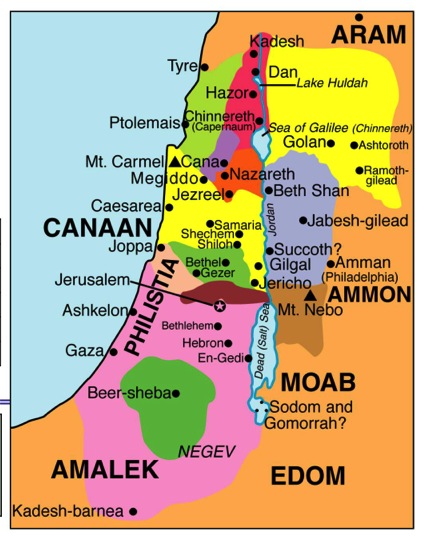Finally, we get to the crucifixion and resurrection of Jesus. These are the chapters upon which our entire faith is based.
CHAPTER 27
This chapter is the second chapter in the book that only contains the words of Jesus and nothing else. This happened two days before his arrest.
Read Matthew 27:1-31.
- Verse 1 – Notice the different locations.

(Click on map to enlarge) – This gives you the likely locations of Jesus’ trials, death, and resurrection. It shows the path from Gethsemane to his trial before the religious leaders at the Palatial Mansion [salmon color], mentioned in chapter 26. From there he is taken to see Pilate (27:1-2) [blue]. He is then taken to see Herod (not told in Matthew’s Gospel) [white], then back to Pilate [yellow]. Finally he walks to the place of crucifixion [green].
Read Matthew 27:32-56.
- Verse 33 – Notice the Place of the Skull.

(Click on photo to enlarge) – This is an alternative location for the crucifixion of Jesus. As you look at the face of the rock, you might see why some suggest they called this “the Place of the Skull.” Most evangelicals want this to be the place – as it is more natural (no church built over it) and therefore more serene and worshipful for us. Yet there is no real evidence beyond the fact that the cliff face looks like a skull.
Read Matthew 27:57-66.
- Verse 57 – Notice the Garden Tomb.

(Click on photo to enlarge) – This is the Garden Tomb and is an unlikely alternative location for the resurrection of Jesus. It is peaceful, worshipful, and enjoyable to visit – as it gives us a reminder of what the surroundings may have been like. We will talk about why this is the desired yet unlikely location of the resurrection of Jesus.
CHAPTER 28
This chapter is the basis of our faith – the resurrection of Jesus. Rather than any more photos or maps – just read and enjoy the story.
Read Matthew 28:1-20.
These two chapters begin with more parables and end with Jesus’ arrest and trial. We are in the final hours of Jesus’ life. As you read, remember the price he paid for your forgiveness and freedom.
CHAPTER 25
This chapter is the second chapter in the book that only contains the words of Jesus and nothing else. This happened two days before his arrest.
Read Matthew 25:1-46.
CHAPTER 26
This chapter contains the last supper, the arrest and the trials of Jesus.
Read Matthew 26:1-16.
Read Matthew 26:17-35.
Read Matthew 26:36-56.
Read Matthew 26:57-75.
These three chapters contain a lot of conflict between Jesus and the religious leaders, and it isn’t surprising that they didn’t like him.
CHAPTER 22
The tension is building between Jesus and all the different religious leaders in Jerusalem.
Read Matthew 22:1-46.
CHAPTER 23
This chapter contains some of the harshest words Jesus ever spoke. Imagine being there and hearing Jesus say such words to your spiritual and religious leaders.
Read Matthew 23:1-4.
Read Matthew 23:5-39.
CHAPTER 24
This chapter begins the last week of Jesus’ life.
Read Matthew 24:1-2.
Read Matthew 24:3-51.
This is day seven of your reading. Jesus starts toward Jerusalem at the beginning of chapter 19 and arrives in Jerusalem at the beginning of chapter 21.
CHAPTER 19
This chapter contains one of my favorite stories – where Peter proclaims Jesus to be the Messiah. We will be at that location next month.
Read Matthew 19:1-12.
- Notice the Jordan River.

(Click on photo to enlarge) – This is a modern photo of the Jordan River. You can see why traveling the Jordan Rift Valley (seen in map 12) was a common way to go between Galilee and Jerusalem because of the valley between the mountains. In Jesus’ day, the river was substantially larger than it is now. Much of the river has been diverted for agricultural purposes by Israel.
Read Matthew 19:13-30.
CHAPTER 20
This chapter begins with a parable and ends with Jesus moving closer to Jerusalem.
Read Matthew 20:1-19.
Read Matthew 20:20-34.
CHAPTER 21
This chapter begins the last week of Jesus’ life.
Read Matthew 21:1-11.
Read Matthew 21:12-46.
This is day six of your reading. It is the final time Jesus will be in the region of Galilee until after his resurrection. Many of these stories will be very familiar.
CHAPTER 16
This chapter contains one of my favorite stories – where Peter proclaims Jesus to be the Messiah. We will be at that location next month.
Read Matthew 16:1-13.
Read Matthew 16:14-28.
CHAPTER 17
This chapter contains four different stories – most of which are not as famous as other stories in the book of Matthew.
Read Matthew 17:1-13.
Read Matthew 17:14-21.
Read Matthew 17:22-27.
CHAPTER 18
This is another well-known chapter with a couple of very familiar stories.
Read Matthew 18:1-6.
Read Matthew 18:735.
This is day five of your reading. These are three great chapters with a lot of geographical movement and well-known stories. Hopefully the photos and maps will be helpful to give you an understanding of where Jesus went.
CHAPTER 13
This chapter contains several well-known parables of Jesus. Next month we will be at the locations where this chapter took place.
Read Matthew 13:1-2.
Read Matthew 13:3.
Read Matthew 13:4-23.
Read Matthew 13:24-35.
Read Matthew 13:36.
Read Matthew 13:37-52.
Read Matthew 13:53-58.
CHAPTER 14
This chapter contains two of the most famous stories of the life of Jesus: Feeding the 5000 and Jesus walking on the water.
Read Matthew 14:1-12.
Read Matthew 14:13.
Read Matthew 14:14-36.
CHAPTER 15
This chapter shares a conflict with the Pharisees that came from Jerusalem. It also is about the faith of a Gentile and another miraculous feeding.
Read Matthew 15:1-2.
- Notice the distance the Pharisees traveled.

(Click on map to enlarge) – This shows how far the Pharisees and teachers of the law travelled to ask Jesus such a seemingly unimportant question. There is more than one route you can take. The most direct route – through Samaria – would be about 90 miles. But these religious leaders certainly wouldn’t have taken that route – since Jews and Samaritans hated each other. So it likely was a route of 120 miles or so – just to ask this question (of course, they had a larger motive).
Read Matthew 15:3-20.
Read Matthew 15:21.
Read Matthew 15:22-28.
Read Matthew 15:29-39.
This is day four of your reading. I’m open to any and all feedback. Is this helpful to give you a “lay of the land”? If you have any thoughts or suggestions, please pass them on to me.
Chapter 10
Read Matthew 10:1-4.
Read Matthew 10:5-42.
Chapter 11
Read Matthew 11:1.
Read Matthew 11:2-3.
- Notice the size of the Dead Sea.

(Click on map to enlarge) – It is easy to assume that John was in prison somewhere near Jesus, but the most likely location for the imprisonment of John the Baptist is on the east side of the Dead Sea. So when John sent his disciples to talk to Jesus – it was a trip that took several days, one way.
Read Matthew 11:4-19.
Read Matthew 11:20.
Read Matthew 11:21-30.
Chapter 12
Read Matthew 12:1-8.
Read Matthew 12:9-10.
Read Matthew 12:11-45.
- Notice the distance between the towns.

(Click on photo to enlarge) – Jesus begins to face some opposition. But remember, this all happens around the Sea of Galilee. Certainly news spread to Jerusalem, but not immediately or quickly. But around the Sea of Galilee, all the religious leaders were now aware of Jesus, concerned about his teachings, behavior, and influence. And the plots begin to end his life.
Read Matthew 12:46-50.
Here are step-by-step instructions for reading. I want to familiarize you with some geography as you read. It will help you next month when we are in these cities, towns and regions. If you are also using a Study Bible – feel free to follow my instructions as you read the Study Bible and read the Study Bible notes. You may want to start by opening all the maps and photos attached in the email. You will be looking at all of them as you read these three chapters.
Chapter 7
Read Matthew 7:1-2.
Read Matthew 7:3-24.
- Notice the house.

(Click on photo to enlarge) – Before building a house the soil had to be removed and bedrock reached. The foundation did not have to be level, but did have to sit on bedrock, so that the house would not move with a landslide due to rain. Jesus would have learned this principle as a carpenter working with his stepfather, Joseph.
Read Matthew 7:25-29.
- This ends the longest sermon of Jesus we have recorded in the Gospels.
Chapter 8
Read Matthew 8:1-5.
- Notice Capernaum.

(Click on photo to enlarge) – In the middle of the photo is Capernaum (with the large gray and white buildings). The white building is the synagogue of Capernaum. The gray building is a Catholic Church built over Peter’s house. You will see those next month. The reddish/brown piece of land on the upper left side of the photo is part of the Mount of Beatitudes. So when Jesus walked to Capernaum, it was not a long walk.
- Notice Capernaum.
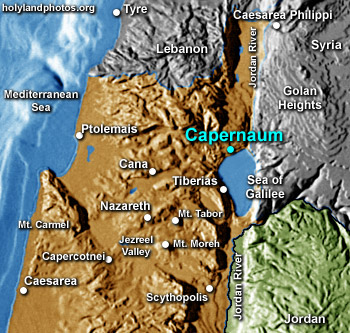
(Click on map to enlarge) – Once again, notice Capernaum. That served as Jesus’ home base for three years. On the map, notice Nazareth, where Jesus grew up. Also notice Cana, the location of Jesus’ first miracle. Notice Mt. Carmel, where Elijah fought the prophets of Baal. And finally, notice Caesarea Philippi, where Peter made his famous proclamation, “You are the Christ, the Son of the living God.”
Read Matthew 8:6-15.
- Notice Peter’s house.

(Click on photo to enlarge) – This is an old photo from the town of Nazareth. What you see here is a 5th century Byzantine church, which was built on top of a fourth century church house, which was built on top of a building from the 2nd century. This is the likely location of Peter’s house. In early centuries, church leaders would build on top of famous locations.
Read Matthew :16-24.
Read Matthew 8:25-28.
Chapter 9
Read Matthew 9:1-18.
- Notice the synagogues.


(Click on photo to enlarge) – Jesus often was in conflict with religious leaders of his day. I always imagined they were from Jerusalem, but many towns had synagogues and therefore, their own religious leaders. These two photos are of the synagogue. It is not the synagogue of Jesus, but it certainly is built on the foundation of the synagogue Jesus would have attended.
Read Matthew 9:19-38.
Here are step-by-step instructions for reading. I want to familiarize you with some geography as you read. It will help you next month when we are in these cities, towns and regions. If you are also using a study Bible – feel free to follow my instructions as you read the Study Bible and read the Study Bible notes.
Chapter 4
Read Matthew 4:1.
- Notice the colored lines.

(Click on map to enlarge) – This shows the likely pathway (salmon-colored arrow) of Jesus from Galilee to be baptized (3:13), and then his journey to the traditional place of his temptation (the light blue arrow). When we are in Israel, there are many places we know for sure. Other places are “traditional” in nature based on decent evidence. And others we simply don’t know where they occurred. Our guide will help us know the certainty of various locations. Certainty comes from a few factors. Archeological evidence is primary. But also how early in church history a location was named as “the” location. Because of the strength of oral communication before the printing press – even one or two hundred years of separation between an event and identifying the location is not a long period of time.
Read Matthew 4:2-11.
- Consider the map and photos above as you read.
Read Matthew 4:12-13.
- Notice northern Israel.
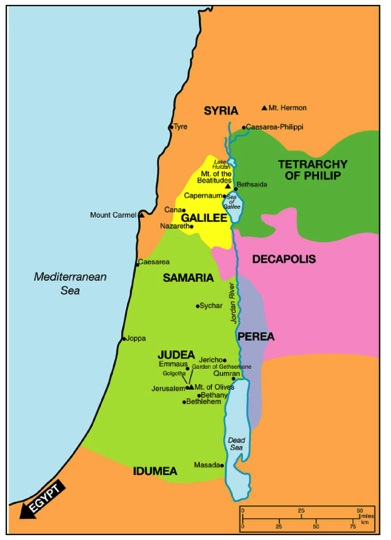
(Click on photo to enlarge) – Several locations are listed here. Notice Galilee is a region of northern Israel (near the Sea of Galilee). Also notice the town of Nazareth (where Jesus grew up) and Capernaum (which became his “home base” during his three-years of ministry.) Take note of how far Capernaum is from Jerusalem. Perhaps you didn’t realize how little time Jesus spent in Jerusalem. He would travel there for required worship feasts, but most of his time was spent in the Galilee region. We tend to assume he was in Jerusalem most of the time because of how many significant events in his life occurred there.
Read Matthew 4:14-22.
Read Matthew 4:23-25.
Chapter 5
Read Matthew 5:1-12.
- Notice the hill where Jesus delivered the Sermon on the Mount.

(Click on photo to enlarge) – This is the location traditionally believed to be the place of the Sermon on the Mount. It is very close to Capernaum. You can see a church building at the top of the hill (“the Church of the Beatitudes”). Have you ever wondered how Jesus could speak to thousands of people at a time with no sound system? Acoustical studies have been done of this area, and on a non-windy day with no cars on the road – a person can stand at the top of the hill and hear a speaker at the water’s edge. This would be a perfect location for Jesus to preach to thousands. This was identified as the location of the Sermon on the Mount well before any acoustical studies were done.
- Notice the Church of the Beatitudes.

(Click on photo to enlarge) – Let me tell you the thing most will like least about going to Israel. This is a church built on the top of the traditional Mount of Beatitudes (Matthew 5:1-12). Well-meaning Catholics have turned as many traditional locations of Jesus’ ministry into churches. Just accept it or it will drive you crazy. Most evangelical pilgrims want to see what Jesus would have seen – not a church built on top of where Jesus had been. Again, it will be a likely frustration you will have. But just accept it and move on. You will enjoy the trip more that way. The worst violations are the place of his birth, death and resurrection. Those will be a bit shocking for you. (Just giving you a fair warning.)
Read Matthew 5:13-48.
- All of this section is from the Sermon on the Mount.
Chapter 6
Read Matthew 6:1-34.
- All of this section is from the Sermon on the Mount.
Here are step-by-step instructions for reading. I want to familiarize you with some geography as you read. It will help you next month when we are in these cities, towns and regions. If you are also using a study Bible – feel free to follow my instructions as you read the Study Bible and read the Study Bible notes.
Chapter 1
Read Matthew 1:1-17.
- Verse 11 – Notice Babylon

(Click on map to enlarge) – When the southern tribes were taken into captivity they went from Jerusalem and the surrounding area to Babylon. 70 years later, God brought them back to Jerusalem. Three times Babylon is mentioned (vv. 11, 12 and 17).
Read Matthew 1:18-25
- Notice Bethlehem.

(Click on map to enlarge) – The salmon line is the likely path that Joseph and Mary took to Bethlehem. The light blue line would be the likely route that the magi took. Although from the east, the best travel route would require them to head north, then down through the country.
Chapter 2
Read Matthew 2:1-6
Read Matthew 2:7-13
Read Matthew 2:14-23
Chapter 3
Read Matthew 3:1
Read Matthew 3:2-6
- Verse 5 – Notice Jericho.
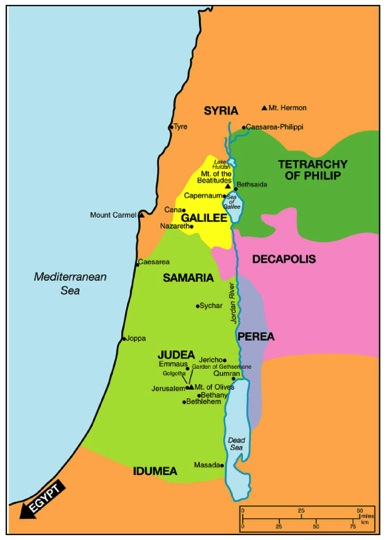
(Click on map to enlarge) – Look at Jericho then look to the east from Jericho until you see the Jordan River. That is the most likely place that John the Baptist baptized Jesus. There are theories that he did it up by the Sea of Galilee, but with the emphasis being on Jerusalem and other factors – I think it was east of Jericho where Jesus was baptized. Did you know one of those going on the trip will be baptized in the Jordan River? It will be awesome!
Read Matthew 3:7-17
A great WordPress.com site












